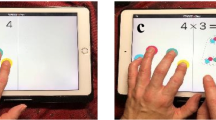Abstract
Many studies have documented the challenges facing teachers who use digital technologies in their classrooms. This is especially true for digital technologies that offer new models or representations of school mathematics concepts. In this article, we report on a collaboration between teachers and researchers around the use of a novel touchscreen application called TouchTimes (TT) designed to provide new models of multiplication. Taking the application as a boundary object, we study the emergence of new meanings of multiplication that arose in group meetings during which the teachers explored TT and reported back on their classroom experiments with TT. We show how these new meanings emerged from a series of disruptions that involved not only mathematical considerations, but also material, political, social and bodily ones.


Similar content being viewed by others
Notes
With the use of the word ‘political’, we refer to power relations that structure and are structured by norms and institutions.
References
Askew, M. (2018). Multiplicative reasoning: Teaching primary pupils in ways that focus on functional relationships. The Curriculum Journal, 29(3), 406–423.
Bakos, S. & Sinclair, N. (2019). Exploring the potential of TouchTimes with primary teachers. In J. Novotná & H. Moraová (Eds), Proceedings of the International Symposium of Elementary Mathematics Teaching (pp. 52–62). Prague: SEMT.
Clark-Wilson, A., Robutti, O., & Sinclair, N. (2016). The mathematics teacher in the digital era: An international perspective on technology focused professional development. New York: Springer.
Davydov, V. V. (1992). The psychological analysis of multiplication procedures. Focus on Learning Problems in Mathematics, 14(1), 3–67.
de Freitas, E., & Sinclair, N. (2014). Mathematics and the Body: Material Entanglements in the Classroom. New York: Cambridge University Press.
Deleuze, G., & Guattari, F. (1987). A thousand plateaus: Capitalism and schizophrenia. Minneapolis: University of Minneapolis Press.
Ferrara, F., & Savioli, K. (2018). Touching numbers and feeling quantities: Methodological dimensions of working with TouchCounts. In N. Calder, K. Larkin, & N. Sinclair (Eds.), Using mobile technologies in the teaching and learning of mathematics (pp. 231–245). Cham: Springer.
Goos, M., & Bennison, A. (2017). Boundary crossing and brokering between disciplines in pre-service mathematics teacher education. Mathematics Education Research Journal, 30(3), 255–275.
Jackiw, N. & Sinclair, N. (2019). TouchTimes [iPad application software]. Burnaby, BC: Tangible Mathematics Group. https://apps.apple.com/ca/app/touchtimes/id1469862750
Kynigos, C., & Kalogeria, E. (2012). Boundary crossing through inservice online mathematics teacher education: The case of scenarios and half-baked microworlds. ZDM - The International Journal on Mathematics Education, 44(6), 733–745.
Nolan, S. B., Horn, I. S., Ward, C. J., & Childers, S. A. (2011). Novice teacher learning and motivation across contexts: Assessment tools as boundary objects. Cognition and Instruction, 29(1), 88–122.
Robutti, O., Aldon, G., Cusi, A., Olsher, S., Panero, M., Cooper, J., et al. (2019). Boundary objects in mathematics education and their role across communities of teachers and researchers in interaction. In G. M. Lloyd (Ed.), International handbook of mathematics teacher education (Vol. 3). Rotterdam: Sense Publishers.
Sedaghatjou, M., & Campbell, S. (2017). Exploring cardinality in the era of touchscreen-based technology. International Journal of Mathematical Education in Science and Technology, 48(8), 1225–1239.
Siemon, D., Breed, M. & Virgona, J. (2005). From additive to multiplicative thinking. In J. Mousley, L. Bragg & C. Campbell (Eds), Proceedings of the 42nd Conference of the Mathematical Association of Victoria (pp. 278–286). Bundoora: MAV.
Sinclair, N., & Heyd-Metzuyanim, E. (2014). Learning number with TouchCounts: The role of emotions and the body in mathematical communication. Technology, Knowledge and Learning, 19(1/2), 81–99.
Smith, D. & Protevi, J. (2018). Gilles Deleuze. The Stanford Encyclopedia of Philosophy (Spring 2018 Edition). Edward N. Zalta (Ed.), http://plato.stanford.edu/entries/deleuze/. Accessed 22 Feb 2020
Star, S. (2010). This is not a boundary object: Reflections on the origin of a concept. Science, Technology and Human Values, 35(5), 601–617.
Star, S., & Griesemer, J. (1989). Institutional ecology, translations’ and boundary objects: Amateurs and professionals in Berkeley’s Museum of Vertebrate Zoology, 1907–39. Social Studies of Science, 19(3), 387–420.
Venkat, H. (2016). Connecting research and mathematics teacher development through the development of boundary objects. In J. Adler & A. Sfard (Eds.), Research for educational change: Transforming researchers’ insights into improvement in mathematics teaching and learning (pp. 182–194). London: Routledge.
Vergnaud, G. (1983). Multiplicative structures. In R. Lesh & M. Landau (Eds.), Acquisitions of mathematics concepts and processes (pp. 127–174). New York: Academic Press.
Author information
Authors and Affiliations
Corresponding author
Additional information
Publisher's Note
Springer Nature remains neutral with regard to jurisdictional claims in published maps and institutional affiliations.
Rights and permissions
About this article
Cite this article
Sinclair, N., Chorney, S., Güneş, C. et al. Disruptions in meanings: teachers’ experiences of multiplication in TouchTimes. ZDM Mathematics Education 52, 1471–1482 (2020). https://doi.org/10.1007/s11858-020-01163-9
Accepted:
Published:
Issue Date:
DOI: https://doi.org/10.1007/s11858-020-01163-9




